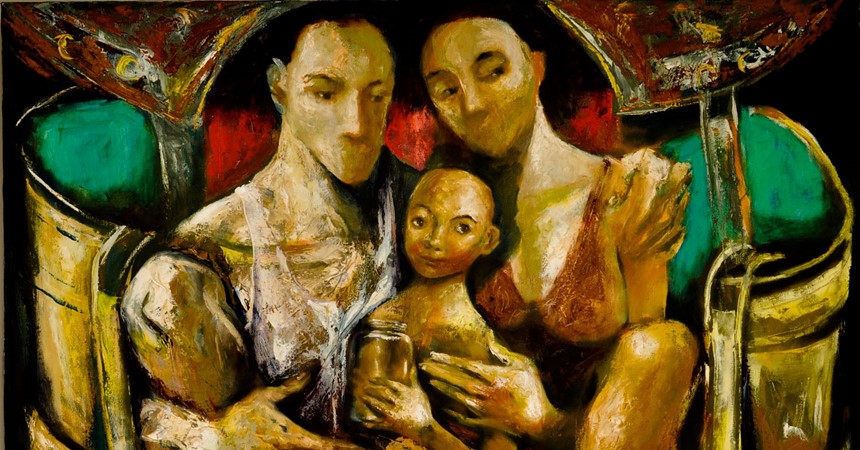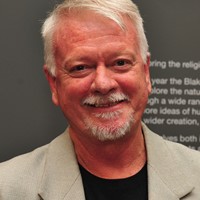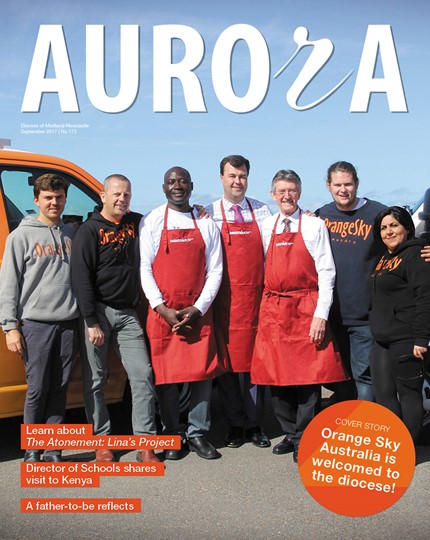All this shopping for happiness and fulfillment leaves us restless and dissatisfied. And yet once again here we are, caught up in the excess of promises that will not be realised. There’s simply too much stuff, too much to do and no time to think about what we really want.
This is why I find this painting by Filipino artist Emmanuel Garibay so shocking. I know from the first look at this work that it is meant to depict the holy family – a symbol of our life together and God’s welcome. But this family ought surely to be clothed in the best garments. I am used to seeing the rich brocades and hand-sewn fabrics of medieval Europe, or the rich colouration of the Renaissance, or occasionally the smart and sensible clothing of contemporary life. But the stark simplicity of this barely clothed but clearly dignified family provides a striking contrast to all my expectations. I want to rush them down to Vinnies for a fresh fit-out with change left over for some great Newcastle fish and chips!
This is a startling image, even in the Philippines where the artist lives and works. It is a strongly Catholic country with a complex history of 400 years of colonial rule by Spain. What is most shocking in this image for its Filipino audience is that the holy family does not look very Spanish. This family does not look like those families who still maintain the balance of power in the politics of the country. These figures look like ordinary people; they are locals, the kind who huddle against those regular typhoons under cardboard walls that have been scavenged around the industrial areas of Manila. They live in the remnant packaging that helps transport the consumer products and clothing that we buy at Christmas. This family is the family of the ghetto, with little over their heads, little to wear and little to eat on their Christmas table.
Their barely clothed appearance should be an offence to us, not just on the basis of our Aussie values, but because it is a sign of injustice and inequality. What is most startling about this family is the dignity and respect with which they engage our eyes, even seeming to reach out and bless us. This delicate, vulnerable child turns to notice and to bless us. The vulnerability found in this work is deeply unsettling. How can such a family maintain its dignity and self-care in the midst of hardship and scarcity? What does that have to do with me? What does the Christ child see as he addresses us with his gaze?
Simplicity might just be the thing. This image carries no other signs of sacred presence like gold and wealth, except for the simple dignity of their humanity. To simplify things, to live with less, to focus on what really matters might be a clue as to how to celebrate Christmas. In our very ordinariness we may discover what is most sacred, most sustaining and nourishing in our lives. One of the bestselling books last year was an unlikely volume written by the members of a US family who, for a year, bought no new goods, but simply made do with what they had. The craving for simplicity, for a healthy move away from endless consumption, is something that is being newly considered. There is now a huge number of books on de-cluttering your life, so many in fact that you would need a new bookcase to house them − but then who has time to read them? Could our most longed-for hopes and dreams be found in the simple things of our human lives? Could life be experienced in ways that are less complex and stressful so we can enjoy what we have, rather than long for more?
The vulnerability of this Sacred Family alerts us to where we might find God in this season. God is the one who resides with us: Emmanuel. This is the good news − God inhabits the vulnerable and complex conditions of own lives just as they are. This holy family is at home with the simple things of life, with no need for the latest gadgets and consumer products. What a relief! This reminds me of what is most important about my life and where I might find the sacred alive in my everyday experience. I don’t need to try harder and do better, but simply to choose the things that matter most. In my affections and efforts to love, God is present. When I am vulnerable and not in control, God is present. When I open myself to the hospitality of strangers, God is present.
By now you will have had a good look at this image. You will have noticed that Mary and Joseph have no mouths through which to speak, they are powerless. They represent all those whose lives and destinies are determined by others, the poor, the displaced, and the refugee. They are seated in what seems to be a jeepney, one of the small open buses that move the 20 million people who live and work in Metro Manila to work each day. This is a family in transit. They are travelling by night, with no possessions, like a refugee family escaping persecution and violence. They have left behind everything that gives them security and simply carry their faith and their dignity in who they are. The Christ child holds a jar, the sort of thing that young children use to catch insects or collect precious objects. It is a container for wonder. But the lid has been lifted and if you look carefully you will see the shape of a heart rising up over the head of the Christ child and settling between the faces of Mary and Joseph. In the midst of stark poverty, Christ lets loose the richness of wonder. The child invites us to welcome the stranger, the sojourner, those dislocated due to war and terrorism into our hearts. If this artwork opens our eyes to see wider and in turn to welcome the stranger into our Christmas celebrations, then perhaps this may be its most shocking dimension? May Christ let loose wonder in your overcrowded life!
Rev Dr Rod Pattenden is the minister at Adamstown Uniting Church and has written widely about contemporary art and spirituality.























































































